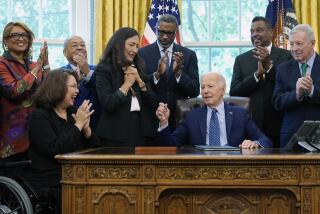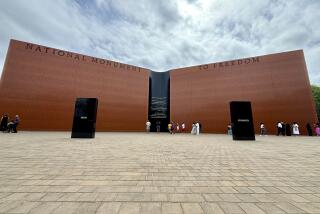Exhibit of Emancipation Document Stirs Emotions
- Share via
WASHINGTON — Did Virginia really have slaves? Is that Lincoln’s handwriting? And that sloppy blotch near Abe’s signature, is that white-out, perhaps covering up one “thenceforward” too many?
The questions came from children huddling in the dimly-lit National Archives rotunda, dwarfed by murals representing the seminal events of America’s founding: the signing of the Declaration of Independence and the ratification of the Constitution.
The adults came for that peculiar Washington experience: to rub up against the icons of history and maybe to see their own lives reflecting back. But even previous visitors to the Archives said they left the building in awe.
The reason was the Emancipation Proclamation, the edict signed by Abraham Lincoln that freed 4 million slaves and hastened the end of the Civil War. A five-day exhibit of the document opened New Year’s Eve, the first time the proclamation has been displayed in its entirety since it took effect 130 years ago on New Year’s Day.
In Milford, Del., people gathered at the Mt. Enon Baptist Church Friday for a solemn celebration, a yearly service marking the document’s signing.
In Washington, the exhibit was a hit.
Hundreds lined up to be among the first to view the display, including crying children and amateur filmmakers with camcorders pushed to their eyes.
It was a religious experience, a curiosity, a civics lesson. For those interested in the latter, some basic facts: Virginia had slaves--plenty. Although Lincoln drafted the speech, a common practice among presidents in those days, the neat, flowing script on the official document was written by a scribe. The splotch marked the place where the presidential ribbon, once a customary part of national edicts, was affixed until it withered and tore.
“I wonder what the folks back home in Springfield would think of this,” said Robert Turner, 39, of his Missouri hometown. “There’s a lot of KKK and neo-Nazi people down there.”
For Turner, who did archival work on a 1937 union strike while he was a student at Southwest Missouri State University, the exhibit inspired “near-religious awe.”
“It’s the only way we can go back in time,” he said. “How are we going to know how to act if we don’t know how they acted?”
Turner said he finds himself wondering if Lincoln freed the slaves because “he needed more troops. On Jan. 1, 1863, the Union was getting its butt kicked.”
It is true that Lincoln was not the single-minded abolitionist portrayed by old civics books. His decision, more pragmatic than philosophical, was designed “not either to save or destroy slavery,” but to “save the union,” he wrote in an 1862 letter. It is also true that 185,000 black men became Union soldiers after the proclamation was signed.
More to Read
Sign up for Essential California
The most important California stories and recommendations in your inbox every morning.
You may occasionally receive promotional content from the Los Angeles Times.










